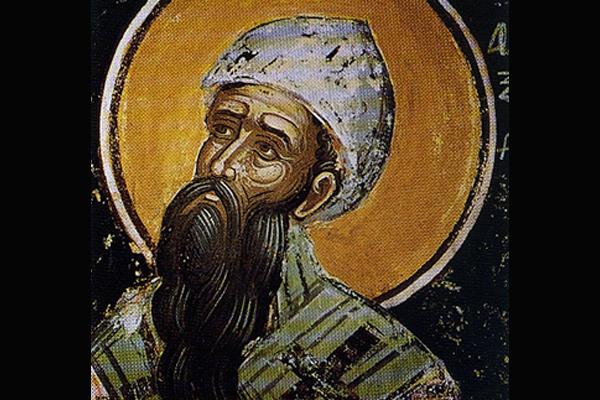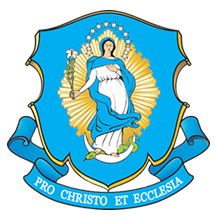
Saint Cyril is credited with being a great champion of orthodoxy. His principal defenses concerning Catholic doctrine centered around the hypostatic union (the one person of Jesus Christ subsisting in His divine and human natures); Mary as Theotokos; and his defense of Christ’s (God’s) Real Presence in the Eucharist.
By Kimberly Bruce
Not your typical saint, St. Cyril of Alexandria, whose feast day we celebrate on June 27, was a “large and in charge” bishop, a bold character of great bravery in the fifth century. He is best known for his defense of the doctrine of the Incarnation (that the one Person of Jesus was the divine Son, the Second Person of the Trinity), and for his brilliant exegetical writings.
Born in Alexandria, Egypt ca. 375 AD, St. Cyril was the nephew of Theophilus, the Patriarch and Archbishop of Alexandria. Saint Cyril received his theological and classical education in Alexandria and was ordained a priest by his uncle. He may have been a monk for a time, as well.
In 402, St. Cyril attended the “Synod of the Oak” with his uncle and witnessed the deposing of St. John Chrysostom, then Bishop of Constantinople. (The Empress Eudoxia did not like St. John Chrysostom, particularly after one of his sermons that she thought was directed at her. Many angry bishops who feared the growing support for the Bishop of Constantinople supported Eudoxia. When the synod deposed St. John, he denied its validity because it was filled with his adversaries. He chose to peacefully go into exile, however, where he died in 407.)
Brash and vehement
Upon Theophilus’ death on Oct. 15, 412, St. Cyril was consecrated his successor. Not the gentlest of saints, St. Cyril expelled Jews from Alexandria because of their murderous attack upon Christians; he pillaged and closed Novatian heretical churches (followers of the anti-pope, Novatian); and performed other strong and forceful acts. He came down hard on Nestorius, Bishop of Constantinople, as well, for his heretical view denying that the two natures of Christ belonged to one divine person, the Son of God.
Brash and vehement at times, many thought St. Cyril went too far. At other times, his decisions were considered too lenient and mild.
Mary as Theotokos
From St. Cyril we hear the term “Theotokos,” a title for the Blessed Virgin Mary recognizing her as “God-bearer” or “Mother of God.” He brought the term into use in 429 in both a paschal letter and a letter to the monks of Egypt. Mary as the Theotokos was another truth of Catholic doctrine to which Nestorius would not assent.
Saint Cyril utilized the term again in 431 at the Third Ecumenical Council, the Council of Ephesus, where he served as Pope Celestine I’s representative. During the council, attended by 200 bishops, St. Cyril and the bishops condemned all the tenets of Nestorianism and deposed Nestorius. Archbishop John of Antioch then arrived with 42 followers who presumed Nestorius innocent in the whole matter. Archbishop John and his followers held a council of their own and deposed St. Cyril.
Due to this confusion, St. Cyril and Nestorius were both imprisoned by the Emperor Theodosius II. Saint Cyril was released three months later when papal legates arrived confirming his innocence and declaring the findings of the true ecumenical council against Nestorius. Saint Cyril was welcomed back into Alexandria. Nestorius retired in Antioch, but was later banished to the Great Oasis of Egypt.
Champion of orthodoxy
Saint Cyril is credited with being a great champion of orthodoxy. His principal defenses concerning Catholic doctrine centered around the hypostatic union (the one person of Jesus Christ subsisting in His divine and human natures); Mary as Theotokos; and his defense of Christ’s (God’s) Real Presence in the Eucharist. He wrote treatises clarifying the above, as well as teaching the doctrine of the Trinity. He wrote commentaries on the Gospels of Matthew, Luke, and John; the books of the Pentateuch; Isaiah; and the minor prophets. He also wrote sermons, letters, and treatises on dogmatic theology.
He authored 17 books “On Adoration in Spirit and in Truth,” 20 books against Julian the Apostate, and treatises addressing the Nestorian controversy. He was a magnificent theologian credited with exceptional reasoning skills.
Saint Cyril of Alexandria died on June 27, 444. He was declared a Doctor of the Church by Pope Leo XIII in 1882, when his feast was officially added to the Roman calendar. He has long been honored as a saint and Doctor of the Eastern Church, where his feast is celebrated on June 9.
Saint Cyril of Alexandria, Bishop and Doctor of the Church, pray for us!
{shopmercy-ad}
















